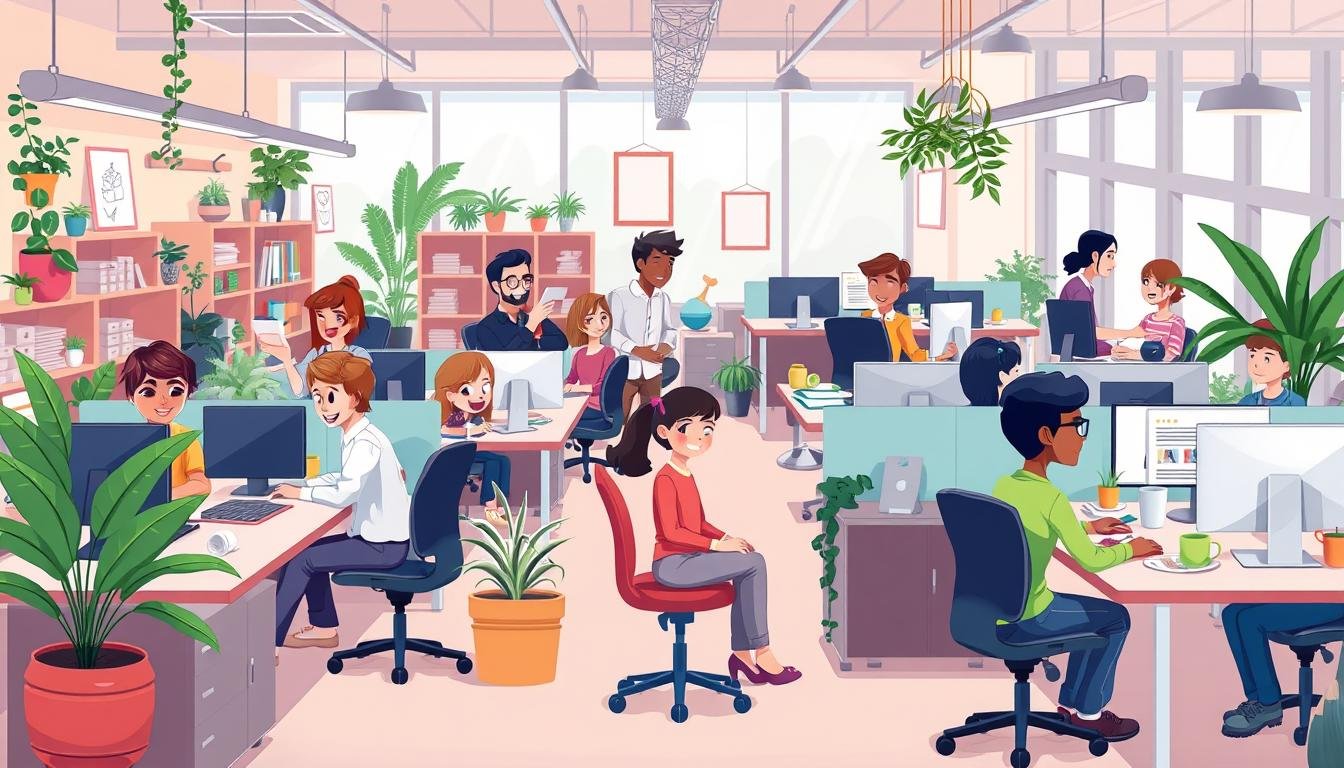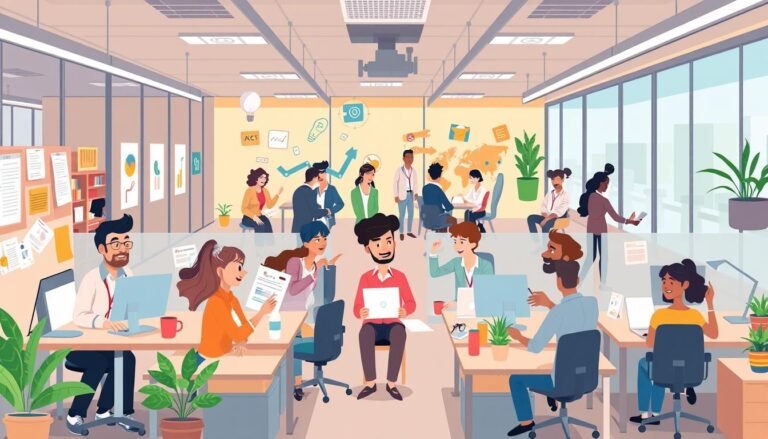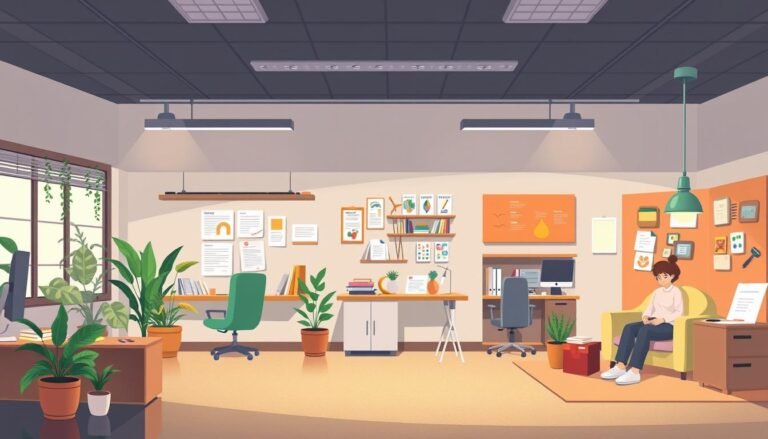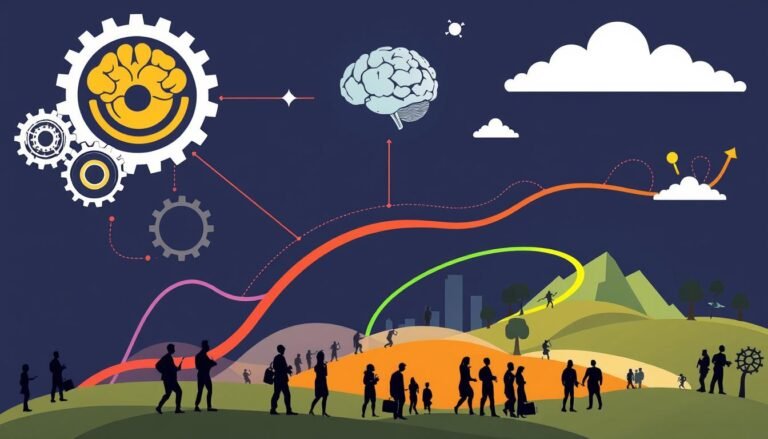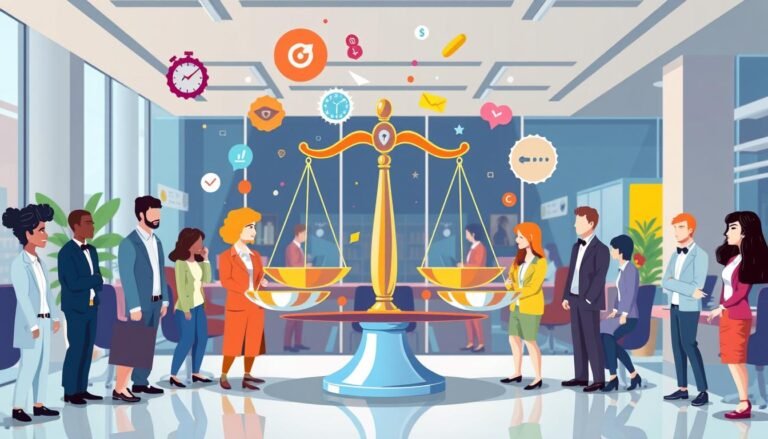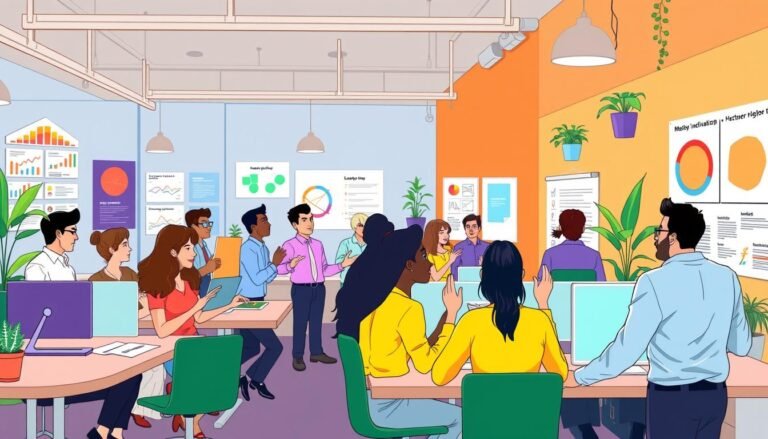Job Design for Maximum Impact: Psychological Insights for Leaders
Are you ready to unlock your team’s full potential? Job design is key to boosting satisfaction and productivity. Let’s dive into how psychological insights can change your job design approach and create a great work environment.
Effective job design is more than just tasks. It’s about making roles that engage employees, use their strengths, and meet company goals. Leaders who get this right can greatly improve their team’s performance and happiness.
Studies show well-designed jobs can make productivity jump by up to 30% and cut down on leaving by 25%. But, only 43% of workers feel good about their team climate. This is a big chance for leaders to make a big difference.
By understanding the psychology of good job design, leaders can make roles that challenge and motivate their team. This not only helps each person do better but also helps the whole company succeed.
Key Takeaways
- Job design significantly impacts employee satisfaction and productivity
- Psychological safety is crucial for innovative performance
- Consultative and supportive leadership promote positive job design
- Well-designed jobs can increase productivity by up to 30%
- Only 43% of employees report a positive team climate
- Leaders play a vital role in creating effective job designs
Understanding the Fundamentals of Job Design
Job design is how work is organized in companies. It makes tasks, duties, and roles to help employees do better and feel good. It’s about making jobs interesting and fulfilling.
Definition and Importance of Job Design
Job design is about setting up work tasks and roles to help both employees and the company. It’s key to making work meaningful and motivating. It looks at what the company needs and what employees can do well.
Key Components of Effective Job Design
Good job design has a few important parts:
- Skill variety: Using different abilities in a role
- Task identity: Completing a whole, identifiable piece of work
- Task significance: Understanding the job’s impact on others
- Autonomy: Having control over work processes
- Feedback: Receiving clear information about performance
Impact on Employee Satisfaction and Productivity
Good job design makes employees happier and more productive. When jobs are well-made, people feel more involved and eager to do well. This leads to better work and less leaving.
| Job Design Factor | Impact on Satisfaction | Impact on Productivity |
|---|---|---|
| High skill variety | Increased engagement | Higher quality output |
| Clear task identity | Sense of accomplishment | Improved efficiency |
| Strong task significance | Increased motivation | Greater effort applied |
| High autonomy | Job satisfaction | Innovative problem-solving |
| Regular feedback | Personal growth | Continuous improvement |
The Psychology Behind Successful Job Design
Workplace psychology is key in making jobs that keep employees engaged and motivated. It involves understanding how work affects our minds, what drives us, and emotional smarts. This leads to better and more fulfilling work places.
Cognitive Aspects of Work Organization
How jobs are designed affects how we think and decide. Good job designs manage information and tasks well. This helps cut down mistakes and boosts performance.
Motivation Theories in Job Design
Getting employees to stay motivated is crucial in job design. Self-Determination Theory says autonomy, competence, and connection are key. By rotating jobs and adding tasks, companies can keep things interesting and help employees grow.
- Job rotation decreases fatigue and stress
- Job enlargement adds task variety
- Job enrichment gives employees more control
Emotional Intelligence and Job Satisfaction
Emotional smarts at work greatly affects job happiness. Jobs that offer social interaction and emotional growth keep employees longer. A big reason people leave is feeling unappreciated, with 79% citing it as a major reason.
“Recurring one-on-one meetings between employees and their managers create consistent avenues for communication, including feedback on projects and performance.”
By applying these psychological insights, leaders can craft roles that meet both company goals and employee needs. This leads to a more engaged and productive team.
Job Design and Employee Well-being
Job design is key to workplace well-being and mental health. Studies show it greatly affects job satisfaction and productivity. A big research project from 2018 to 2022 gave us important insights.
A study by Böckerman et al. (2020) showed jobs well-designed can make workers happier. Companies focusing on ergonomic design saw a 55% drop in physical problems. This shows the need to think about both mental and physical health in job design.
Jobs with variety and complexity are better for mental health. They led to 40% less burnout than simple jobs. Also, jobs with more freedom made workers 30% happier, showing the value of flexible work.
| Job Design Factor | Impact on Employee Well-being |
|---|---|
| Ergonomic Design | 55% reduction in physical ailments |
| Task Variety | 40% less burnout |
| Autonomy | 30% increase in job satisfaction |
| Regular Feedback | 25% increase in morale and motivation |
| Work-Life Balance Focus | 20% decrease in absenteeism |
Daniels et al. (2017) found a link between job design, work practices, and well-being. Companies that valued work-life balance had 20% less absenteeism. Teamwork also boosted mental health, making workers 15% happier overall.
“Effective job design is not just about productivity; it’s about creating an environment where employees can thrive mentally and physically.”
Leadership’s Role in Implementing Effective Job Design
Leaders are vital in shaping job design in organizations. Their approach greatly affects employee happiness and work output. Let’s look at how leadership impacts job design and its role in success.
Transformational Leadership and Job Design
Transformational leadership is crucial for engaging job designs. Leaders who inspire and motivate can improve performance by up to 30%. This method aligns job roles with company goals, giving team members a sense of purpose.
Balancing Organizational Goals with Employee Needs
Good leaders know how to balance company goals with employee happiness. This balance can lower turnover and boost productivity. For example, promoting from within can raise morale and offer growth chances, even with few job openings.
Fostering a Culture of Continuous Improvement
Leaders who support continuous improvement create flexible job designs. They use strategies like job rotation to help employees learn new skills and gain varied experiences. This approach boosts individual growth and supports succession planning.
- Job enrichment increases employee engagement
- Job enlargement broadens skill sets
- Job crafting empowers employees to shape their roles
By focusing on these areas, leaders can create a work environment that meets both company goals and employee needs. This balance is key for long-term success and growth in today’s fast-changing business world.
Job Analysis: The Foundation of Effective Job Design
Job analysis is key to good job design. It looks at what a job needs, what tasks are involved, and who does them. This step helps decide who to hire, how to train them, and how to manage their work.
Leaders use job analysis to make roles that fit the company’s needs and the skills of its people. They gather data through talking to employees, surveys, and watching how they work.
A detailed job analysis shows:
- 5 to 12 main duties per job
- 30 to 100 specific tasks
- What knowledge, skills, and abilities are needed
- Possible safety risks
This info helps decide who does what and how roles are defined. It makes sure jobs are interesting and rewarding. Job analysis also helps meet legal rules about work conditions, pay, and promotions.
| Job Analysis Benefits | Impact on Job Design |
|---|---|
| Identifies essential job components | Informs task allocation |
| Reveals required skills and abilities | Guides role definition |
| Uncovers potential hazards | Enhances workplace safety |
| Ensures legal compliance | Supports fair HR practices |
Doing job analysis regularly keeps roles in line with company goals and employee skills. This ongoing process helps improve and adapt to changing work needs.
Ergonomics and Physical Workplace Considerations
Workplace ergonomics has changed a lot over the years. We’ve moved from open rooms to cubicles and private offices. Now, we focus on making spaces that help workers do their jobs better and feel less tired.
Designing for physical comfort and safety
A good workspace keeps workers healthy and safe. It helps prevent injuries and makes them feel better mentally and physically. Important things include sitting right, not using too much force, and having things close by.
- Ergonomic furniture
- Proper lighting
- Tailored acoustics
- Adequate clearance
Integrating technology in job design
Technology is key in keeping workplaces safe today. Ergonomic computers and tools help avoid injuries from doing the same thing over and over. Companies can get help to make their offices both useful and comfy.
Adapting to remote and hybrid work models
Remote work has changed how we think about ergonomics. People need tips on making their home offices good for their backs and eyes. Hybrid work needs spaces that can change with the day’s tasks.
| Ergonomic Improvement | Benefit |
|---|---|
| Proper furniture | Reduces physical strain |
| Optimal lighting | Decreases eye fatigue |
| Noise management | Enhances focus |
| Flexible workspaces | Supports varied tasks |
At first, making a workplace ergonomic might seem expensive. But it saves money on injuries, missed work, and hiring new people. A well-made workspace makes workers more efficient and happier in their jobs.
Psychological Safety and Job Design
Job design is key to creating a safe team environment. A well-designed job lets employees feel safe to take risks and share ideas. This safety is vital for innovation and solving problems.
Studies show that focusing on psychological safety brings big benefits. For example, CGI’s recognition tool use more than doubled in a quarter after the pandemic. This shows a strong focus on valuing employees.
Leaders can make jobs safer through thoughtful design:
- Create clear norms for a safe working environment
- Encourage open communication and idea sharing
- Provide dedicated time for focused work, like League’s “flow time”
- Implement regular cohort meetings for strategic development
Workplace design also affects safety. Natural light, a top amenity for hybrid workers, boosts physical and mental health. Adding biophilic elements in offices improves cognitive function and mental health.
By focusing on these job design aspects, leaders can foster a safe team climate. This leads to more creativity, problem-solving, and team success.
Skill Variety and Task Identity in Job Design
Job design is key to making employees happy and productive. The Job Characteristics Model (JCM) from 1975 highlights five main job traits. Let’s dive into how skill variety and task identity help in designing better jobs.
Enhancing Job Complexity for Engagement
Skill variety adds depth to a job. It’s about using different skills for various tasks. For instance, primary school teachers use many skills with different kids. This variety keeps employees engaged and stops boredom.
Balancing Specialization and Diversification
Task identity is about finishing a complete project. HR generalists, for example, handle many tasks in employee management. Yet, they might struggle with getting feedback. Finding the right mix of specialization and variety keeps jobs interesting and efficient.
Fostering a Sense of Ownership and Pride
Task significance is about how much a job affects others. A school principal, for example, impacts many areas of the school. Highlighting the value of each role boosts employee pride and motivation.
Source Links
- Job Design: A Practitioner’s Guide
- Psychological safety and the critical role of leadership development
- Designing work for well-being
- Principles of Job Design | Human Resources
- Job Design Process, Strategies & Models Explained
- Job Design Theories | Human Resources Management
- 6.2 Motivating Employees Through Job Design
- How to Design a Job That Motivates Employees
- Job design needs a health-check: Part 1 – HR Magazine
- The Link Between Job Design and Employee Health
- Job Design: 6 Strategies for an Effective Job Design
- The Leader’s Role in Supporting Strategy, Organization Design and Culture
- Job Design: An Integrated Approach to Creating Effective
- CIPD | Job Design | Factsheets
- What is the relationship between job analysis and job design?
- Job Analysis: A Practical Guide [FREE Templates]
- Ergonomic Workplace Design and Your Business | Medcor
- Ergonomics and Workplace Design
- Psychological Safety At Work Is More Important Than Ever And Here’s Why—Part 2
- Designing the Workplace for Mental Health
- Job Characteristics Model: A Practical Guide
- Job Characteristics Model (JCM): What You Need To Know – Shiftbase

